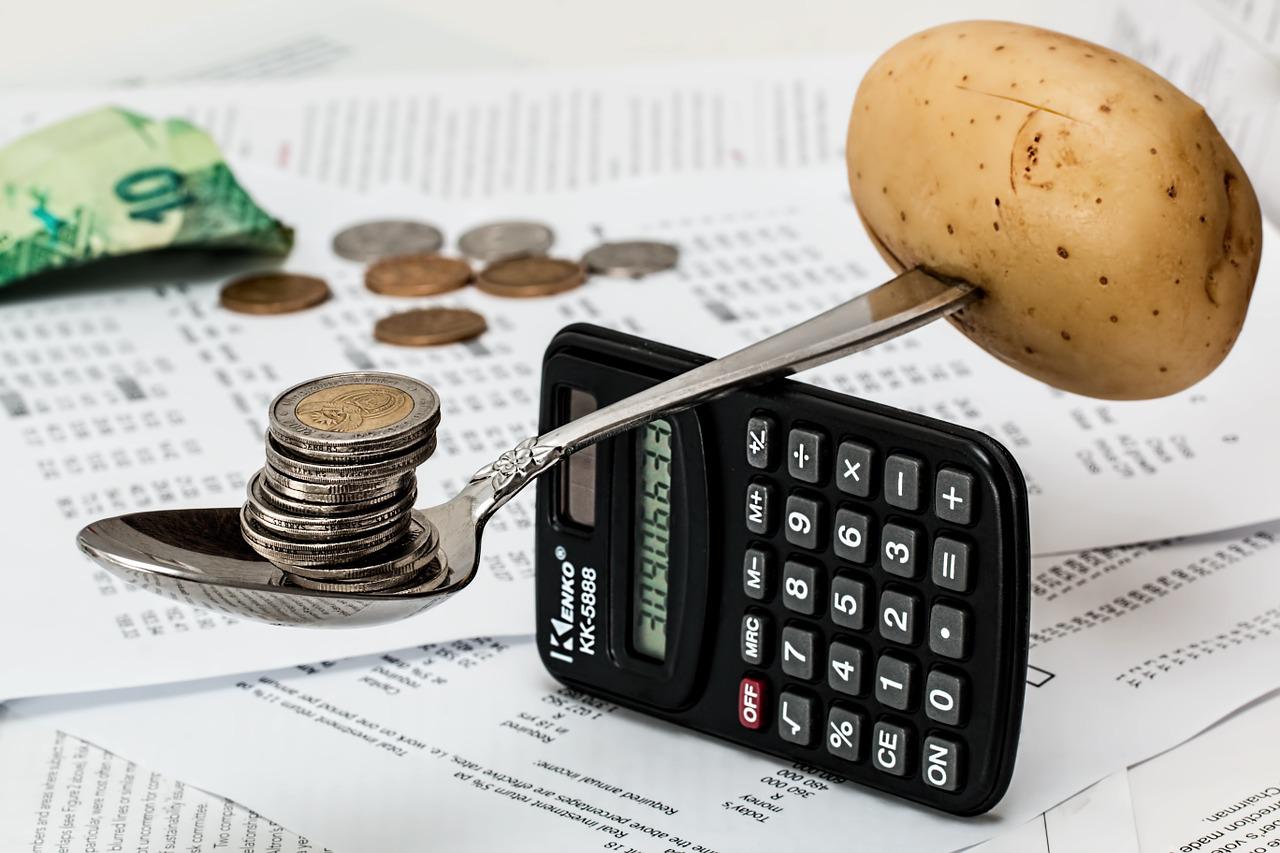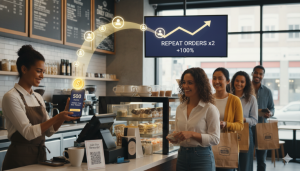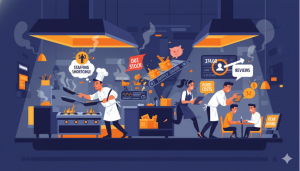One of the most important aspects of owning a restaurant is keeping food costs low. Uncontrolled food expenses can cause challenges for all sorts of restaurants, regardless of their location.
Restaurant owners must calculate food costs regularly and precisely to stay afloat. Due to restaurants’ razor-thin profit margins, it’s critical to use a food cost formula that provides specific cost proportions for everything from raw materials through processing.
In 2018, the Saudi Arabian food business generated $150 million in revenue. This increase was 19 percent more than the previous year’s earnings.
The market for restaurants and cafes is estimated to be worth $5.7 billion.
Saudi Arabia and the United Arab Emirates account for 90% of the drink and food sector in the Gulf Cooperation Council district.
Since the food market in Saudi Arabia is so competitive, it’s critical that your restaurant not only focuses on the customer experience but also takes the time to review how to operate the business and how to spend money.
Using a food cost formula to compute food prices will assist in verifying that your company is spending money and profiting as it should be.
Here’s all you need to know about using the food cost formula to apply and calculate your restaurant’s food expenses.
What is a Food Cost Formula?
When we talk about food cost, we refer to the actual food cost.
You may estimate the actual food cost by calculating inventory consumption and food sales.
Actual food costs = Inventory Usage/Total Food Sales, where Inventory Usage is the price of the inventory utilized in the week for a specific dish. Total food sales are the income of the total number of sales of that dish for the whole week.
By comparing the initial and final inventory, you can determine inventory use. What you have before opening on the 1st of the month is your beginning inventory. The remaining inventory at the end of the month is your ending inventory. You’ll also need to include any inventory you ordered throughout the month (purchases).
Thus, Inventory usage = Beginning inventory + New inventory purchases – Ending inventory.
The total money generated by the dish is what the total food sales define. Multiply the total number of products sold over the month by the sales price.
Therefore, Total food sales = Sales Price of the dish * Number of units (plates) sold.
Do this for every item sold, then sum them all together to determine the total sales for your restaurant.
Why You Should Use a Food Cost Formula
It’s critical to employ a food cost formula because it’s one of the most crucial indications of a restaurant’s profitability.
There are various explanations for why such calculations are essential.
For starters, one of the most significant expenses for most restaurants is the cost of the food. Second, percentages of food costs can influence menu prices and profit margins. Finally, excessive food expenses might have a detrimental impact on a restaurant’s profitability.
As a result, it can aid in budgeting and forecasting. Restaurants may better comprehend the profit margins on each item and determine if it is worthwhile to add a particular dish to the menu by understanding how much each dish costs the restaurant to prepare.
Knowing your food cost percentage will empower you to make informed menu pricing selections that benefit your bottom line positively.
Here are some examples of how understanding your food cost percentage might assist you.
- Determine how much you spend on meals in comparison to other restaurants
When you compare your food cost percentage to industry standards, you can see if your expenditure is typical or needs altering.
When comparing your costs to those of your rivals, the cost of doing business acts as a benchmark.
Depending on the restaurant’s niche, the food cost percentage might range from 20% to 66%.
This percentage is an excellent way to estimate your profit margin since it tells you if you should use cheaper ingredients to cut your food cost per serving or use other methods to boost your profit margin.
- Know how profitable your menu items are.
You’ll be able to grasp the profitability of your meals once you’ve determined where your food cost percentage stands concerning benchmarks.
Many food entrepreneurs fail to develop their menus properly. As a result, there are instances when the price of particular menu items is too high, resulting in reduced sales volume.
You will be able to re-negotiate your conditions or look at the portion size to minimize the amount for any specific dish if you have an exact estimate on food cost and profit margin.
You will be able to re-negotiate your conditions or look at the portion size to minimize the amount for any specific dish if you have an exact estimate on food cost and profit margin.
You may also enhance the sale price of your items if your menu is well-designed and engineered.
How to Reduce Your Restaurant’s Food Costs
One technique to decrease food expenses in restaurants is to compare ideal and actual food prices to uncover food waste concerns.
Here are six more things you can do to save costs and enhance your bottom line.
-
When Calculating Inventory, be Consistent
When estimating your inventory, you should do so regularly throughout the day. It’s ideal to calculate your inventory at the start or finish of each day, for example.
By adopting a regular schedule, you will keep figures consistent when calculating inventory and your food cost percentage.
Regularly checking your inventory may provide you an insight into how and at what rate your food is being consumed or discarded.
-
Minimize Food Waste
You should keep track of all dishes that return to the kitchen in addition to inventory.
Adjust portion sizes if a specific dish is frequently returned with a considerable quantity of food left on the plate.
Controlling your meal amounts is a great strategy to cut down on wastage.
Keep track of how much food is thrown away. If your consumers are regularly unable to finish a meal, the serving is too large.
To provide the correct quantity of food to your guests, use restaurant portion control instruments like portion scales and portion spoons. Food waste reduction benefits both the environment and your bottom line.
You might also use the first in, first out strategy. The first-in, first-out method is simple: utilize the first ingredients you put into your cabinets and freezers.
This method compels you to utilize the oldest food first, ensuring that you always have fresh ingredients on hand and preventing food from going bad.
-
Implement Gradual Price Increases
Start with smaller incremental price increases rather than fast boosting prices to prevent or reverse the loss.
If your price increases are minor, your customers are less likely to complain about price hikes.
This price hike is especially effective for menu items that already have a higher selling price to cover the cost of the ingredients.
-
Keep Your Employees Informed and Updated
It’s critical that your employees understand the cost of your food and how their behavior might affect your bottom line.
There might be a lot of waste during the meal preparation process. While the expense of such waste may appear modest at the moment, it can quickly add up to become a significant loss.
As a result, if your team understands how much food costs and how to use it correctly, they will be more careful while making meals and portioning dishes.
-
Stay Up to Date on Seasonal Price Fluctuations
Since some ingredients are more easily accessible than others, your wholesalers’ prices will most likely fluctuate seasonally.
Stay updated on food costs to see how they affect your shopping list. Make any necessary changes to your menu or pricing.
To save money on produce, eat seasonal foods. Seasonal cuisine varies depending on where you live, so go to your local farmers market to see what’s new and get ideas for fresh meals.
Change your menu and upsell more popular and lucrative meals or use seasonally limited-time food offers to prevent going too near your break-even cost if ingredients go up in price or if a specific dish loses appeal.
-
Work With Your Suppliers
You may work with your suppliers to reduce your food prices once you know how much food your restaurant utilizes at any one moment.
If feasible, look around to discover what other vendors have to offer. If you have an excellent working connection with your present provider, you might ask for a discount or for them to match their rivals’ rates.
Alternatively, you can devise a strategy in which you buy in bulk but have the order delivered over multiple shipments rather than at once.
Ordering food in bulk might save money, but it can also lead to food spoilage, negating any savings you would have made by buying in bulk. Having your shipments delivered in many installments guarantees that you’re constantly offering fresh food, minimizes food waste, and saves you money.
The majority of Saudi food manufacturers rely on imported ingredients. In 2019, Saudi Arabia imported $2.7 billion in intermediate food goods, primarily for further processing.
When buying food, you have the option of bypassing the intermediary and buying directly from the source: local farms and farmers’ markets.
Saudi Arabia consumes almost 32.9 million tonnes of food and beverages each year. Buying locally assures you receive the freshest items while supporting your community’s economy.
Using a Food Cost Formula for Your Restaurant
When you utilize the food cost formula in conjunction with the recommendations above regularly, it works best.
It’s important to remember that you shouldn’t just compute your food cost percentage and stop there. Utilize the data to discover the components that are causing a cost increase. You can then look for alternative low-cost vendors to make these purchases from.
Every dollar you save will improve your revenues, allowing your company to expand.
Cost-price optimization can help you keep your business profitable and enhance the value of your inventory.
Finding data to incorporate into the food cost formula can be challenging, with so many restaurants coming online to give customers online ordering and food delivery.
Blink’s online ordering platforms provide your brand with not just a digital storefront for your restaurant but also valuable data on food sales and customer preferences.
Blink’s quick commerce enablement platform provides you total control over all of your customer data, as well as business analytics capabilities to help you assess how well your restaurant is functioning.
[INSERT_ELEMENTOR id=”10819″]
Related Articles:
 Social Media Marketing for Restaurants (New Guide)
Social Media Marketing for Restaurants (New Guide)
 Marketing Restaurant Ideas and Trends For Startups in 2021 (New Guide)
Marketing Restaurant Ideas and Trends For Startups in 2021 (New Guide)
 What is a Point of Sale System and how Does It Work?
What is a Point of Sale System and how Does It Work?
 5 Free & Best Restaurant SEO Tips to Boost Your Online Presence
5 Free & Best Restaurant SEO Tips to Boost Your Online Presence
 Importance Of Restaurant Contactless Delivery & How To Implement It
Importance Of Restaurant Contactless Delivery & How To Implement It







